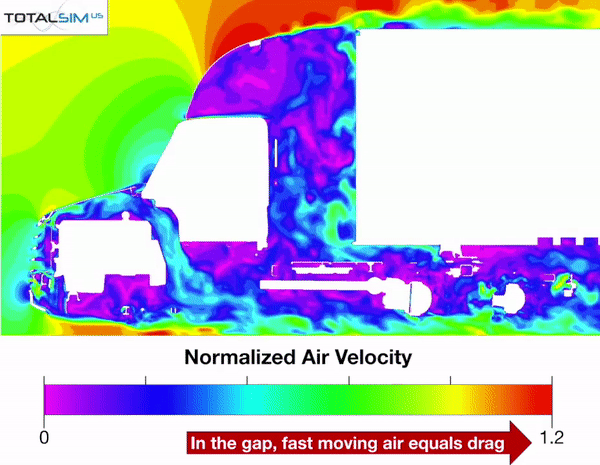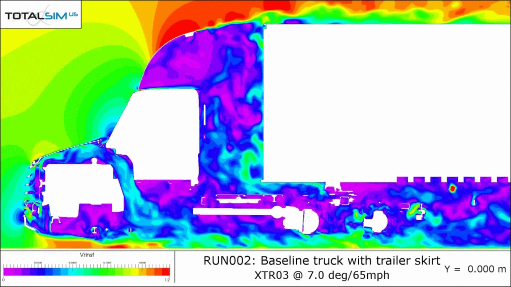5 Ways to Improve Semi-Truck Aerodynamics and Reduce Fuel Costs
Rising fuel prices - topping off at more than 75 percent higher than last year - have left the trucking industry scrambling for solutions to reduce fuel costs and improve the efficiency of their fleets.
Diesel prices have reached record levels and not since the 1970s has there been a tougher time to manage fuel hikes and keep trucks running.
The seemingly endless trend in the wrong direction has trucking operators turning their attention from the inside of the tank to the outside of the truck, reconsidering truck aerodynamics and new advances in products and devices that curb their losses.
The Impact of Aerodynamics on Fuel Economy
Semi-truck aerodynamics plays a large role in how fuel efficient a truck can be when traveling at high speeds along an interstate highway.
At highway speeds, a semi-truck consumes more than half of its fuel by pushing through air resistance created by the size and shape of the semi-truck and trailer. This so-called aerodynamic drag decreases fuel efficiency.

That drag is created along multiple points of the truck and trailer, including the front of the truck, the gap between the trailer and the tractor, the sides and underbody of the trailer, and the back of the trailer. The smoother the airflow around those points, the lower the drag.
Improving aerodynamics can deliver significant fuel cost savings. In fact, industry reports indicate that using multiple devices to reduce aerodynamic drag can reduce trucking industry fuel consumption by more than 12 percent - or some $10 billion in diesel fuel costs.
The Most Common Drags
Trucking companies have popularized many products over the years that improve semi-truck aerodynamics, including streamlined shields, trailer skirts, trailer tails, and devices that cover the gap between the tractor and trailer.
All are directed at reducing the percentage of drag created by each aerodynamic-resistant component of a truck and trailer.
Among the leading offenders on a truck, when it comes to wind resistance, is the gap between the tractor and the trailer, which can produce 25 percent of the overall drag. Any gap of 18 inches or more between the tractor and trailer can produce increased air resistance, researchers say. Covering the gap can reduce drag by as much as 9 percent.
The front end of a tractor also produces a significant amount of drag or about 25 percent. Many truck manufacturers are eyeing the front of the truck for more aerodynamic design, including sloped front windshields and pedestal door mirrors.
All along the side of a semi-trailer, aerodynamics are impacted, along with the underbody. Combined, that’s another 25 percent of overall drag created by a tractor-trailer rolling down a highway.
Finally, the back of the trailer creates yet another point of drag when air gets trapped around the tail.
5 Easy Ways to Improve Semi-Truck Aerodynamics
Devices on the market today can create much-improved aerodynamics on semi-trucks and are readily available. Here are five leading ways to boost fuel efficiency.
- Reduce the gap between truck and trailer: Using an aerodynamic device to cover the gap can significantly reduce drag and improve fuel efficiency. Trucking industry giant Ryder System, Inc. partnered with us to use our TruckWings device, which delivered them a fuel saving of 4.1 percent. TruckWings automatically deploys at speeds above 52 mph, covering the gap without any distraction to the driver, and retracts when speeds drop below 50 mph, allowing for safe maneuverability on surface streets.
- Reduce airflow underneath: Side skirts reduce airflow underneath trailers, leading to fuel savings of more than 4 percent, according to manufacturers.
- Minimize tail drag: Trailer tails, or “boat tails” that reduce turbulence can knock fuel costs down by around 6 percent for semi-trucks traveling at 65 miles per hour
- Check your wheels: Wheel covers allow air to flow past the tires, reducing aerodynamic drag.
- Make mud flaps aerodynamic: Switch from heavy, solid rubber flaps to slotted mudflaps, which allow air to pass through them.
Improve Aerodynamics, Cut Fuel Costs
In the face of unprecedented fuel costs, fleet owners are finding a growing number of options on the market for improving truck trailer aerodynamics and creating fuel-efficient designs.
Leading the way in preventing costly wind resistance is TruckWings, providing an accessible, automated aerodynamic option that can significantly trim fuel costs across an entire fleet.
Ready to face down fuel inflation? Get in touch today and learn more.



